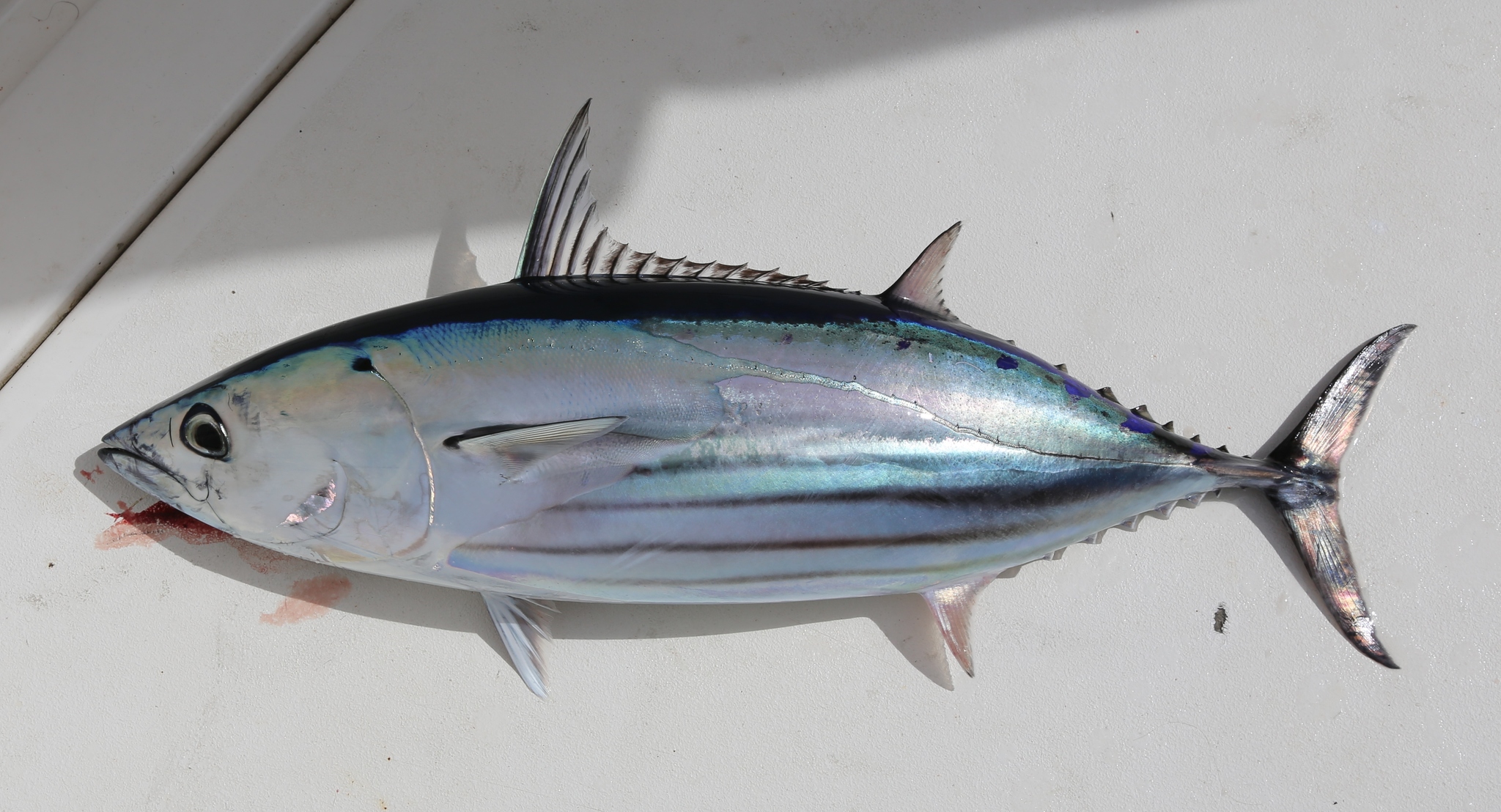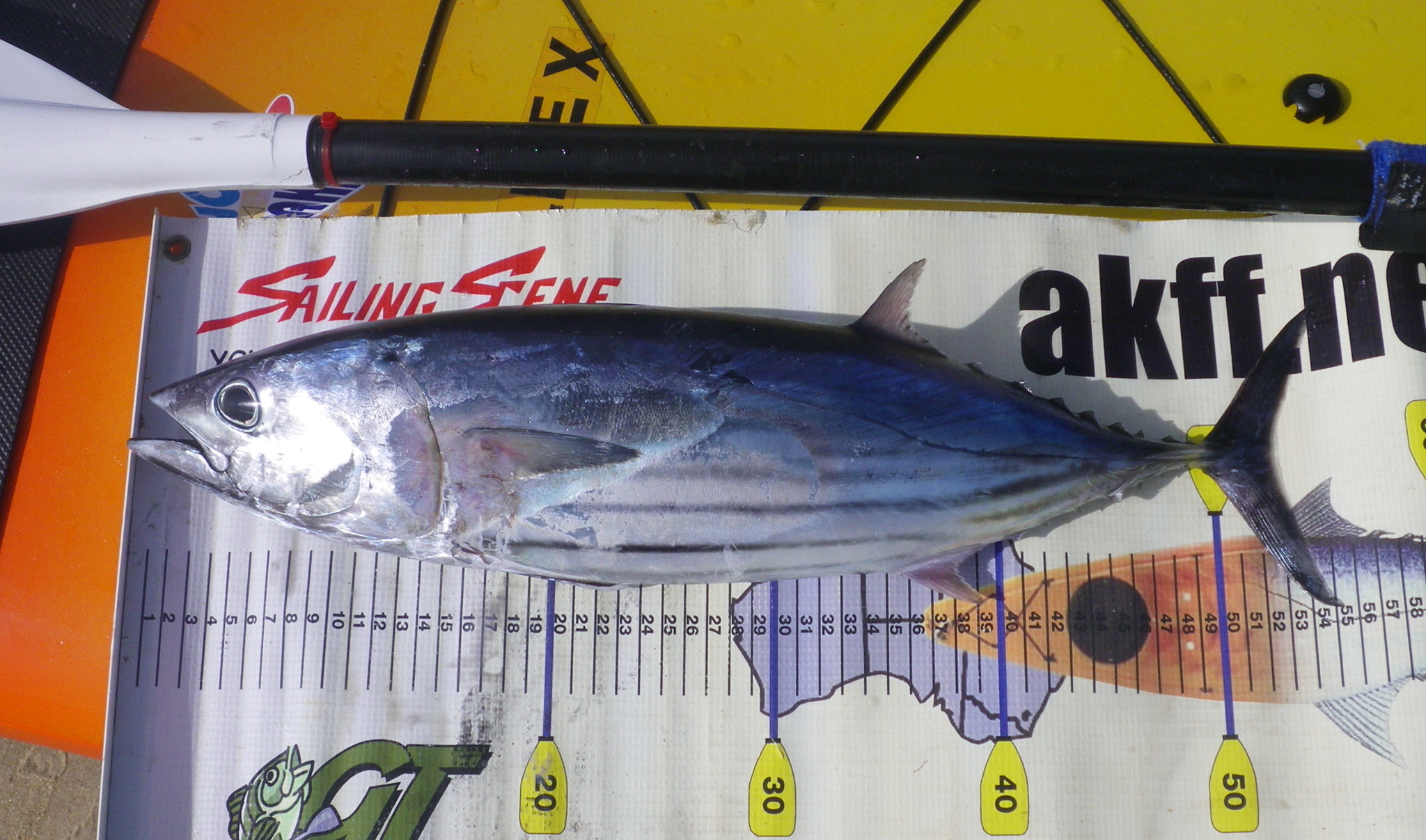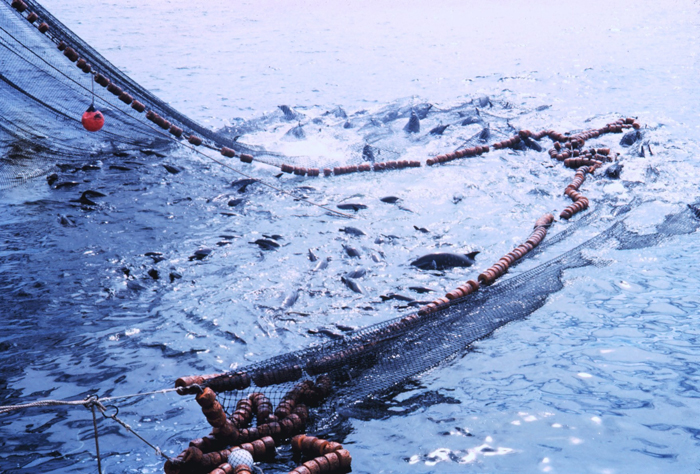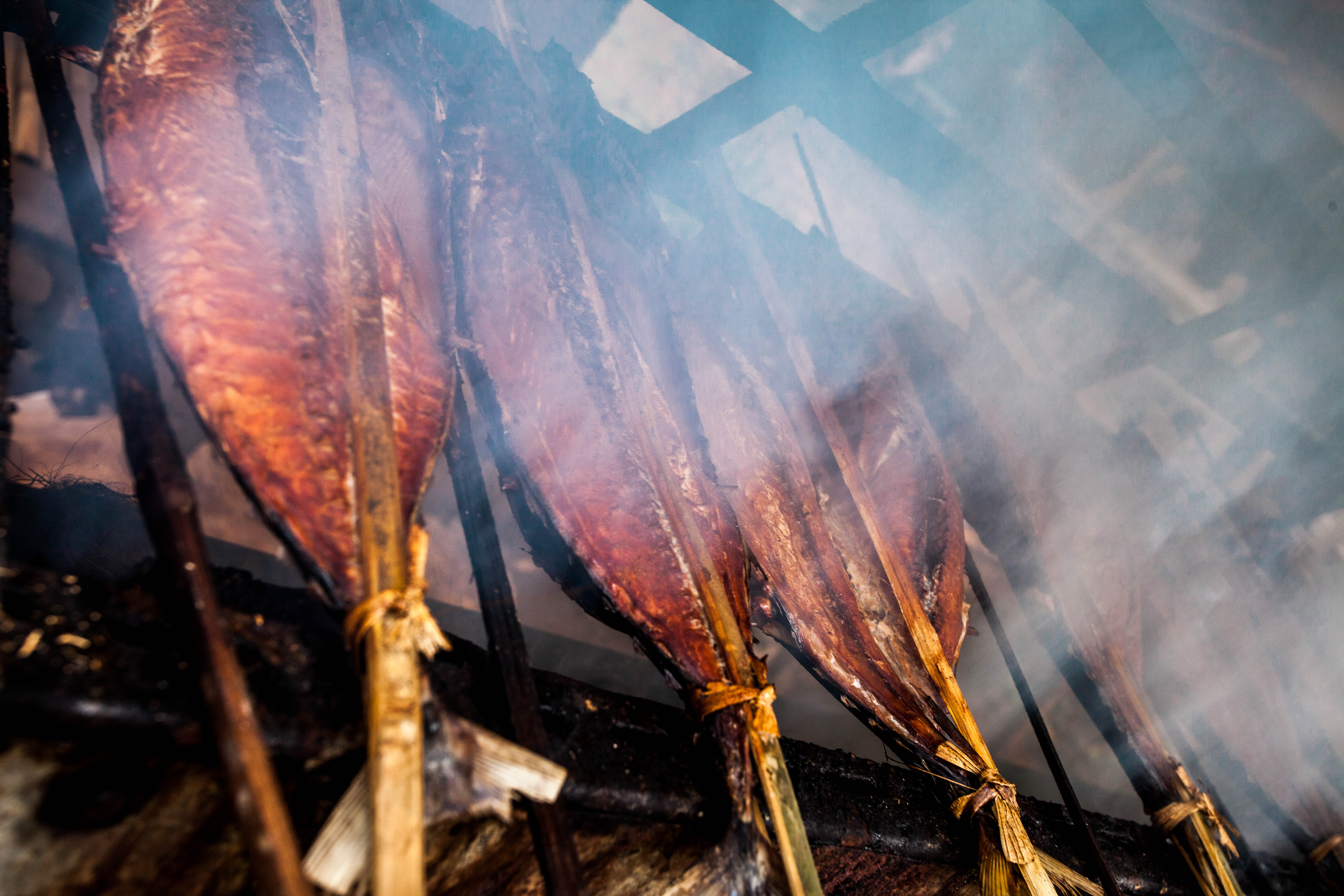Katsuwonus pelamis
North Coast (Oregon Border to Point Arena)
North Central Coast (South of Point Arena to Half Moon Bay)
Central Coast (South of Half Moon Bay to Point Conception)
Santa Barbara (Point Conception to Point Dume)
South Coast (Point Dume to Mexico border)
Firm fish
Flakey fish
Wild caught

The Science

Taxonomic description
- Has a silver body, with a dark blue-black back, and four to six dark stripes along its sides. [2,4]
- Has very few scales, except for along its lateral line and head. [4]
Distribution
- Found throughout Pacific, Atlantic, and Indian Oceans in tropical and subtropical waters. [1,2,4]
- Highly migratory. [1,2,4]
Life history
- Has a life span of 7-12 years. [1]
-
Matures around 1 year of age and around 39.6 cm (1.3 ft) long, and it can grow up to 1.2 m (4 ft) and weigh over 70 pounds. [4,6,7]
- Spawns all year long in equatorial waters and females can lay up to two million eggs. [1,2]
- Through broadcast spawning, released eggs are fertilized and hatch one day later. [7]
- Often found in schools of thousands for hunting and reproduction. [3]
Habitat
- Lives in the pelagic zone, spending most of its life in the open ocean. [7]
- Schools with bigeye and yellowfin tuna. [7]
- Predators of skipjack tuna includes large pelagic fishes, including billfish, larger tunas, and sharks. [6,7]
- Preys on other fish, crustaceans, mollusks, and other tunas. [4,6,7]
The Fishery

Seasonal availability
- Available year round. [5]
Regulatory and managing authority
- Internationally overseen by the Inter-American Tropical Tuna Commission (IATTC) and the Western and Central Pacific Fisheries Commission (WCPFC). [5,6]
- Along the Pacific West Coast, the fishery is overseen by NOAA fisheries and, as established by the Magnuson-Stevens Act, the Pacific Fishery Management Council through the West Coast Highly Migratory Species Fisheries Management Plan. [5]
- As established by the Marine Life Management Act, the California Department of Fish and Wildlife (CDFW) collects data on this fishery through the Pelagic Fisheries and Ecosystems Program. [10,11]
Gear type
- Gear used include purse seines, troll, artisanal handline, pelagic longline, pelagic hook-and-line, and pole-and-line. [4,5,7]
- Purse seines are predominantly used. [5]
Status of the fishery
- Skipjack populations are difficult to assess due to high and variable productivity, but populations are thought to be stable and not overfished or subject to overfishing as of a 2015 stock assessment. [5,7]
- Rapid growth and reproduction rates help tuna resist fishing pressure. [7]
- The Fishery Management Plan for U.S. West Coast fisheries for Highly Migratory Species management includes:
- Permits and documentation of catch. [5]
- Gear constraints and requirements for operation. [5]
- Large vessels require observer coverage and other vessels are subject to observer requests by NOAA. [5]
- Measures have been adopted from the WCPFC and IATTC to regulate catch of juvenile tuna effecting other species through use of purse seine. [5]
Potential ecosystem impacts
- When large purse-seine nets are set around Fish-Aggregation-Devices, there is a substantial amount of bycatch, including: other fish, sharks, rays, and sometimes even sea turtles, whales, or dolphins. [2,5,7,9]
- Because fishing gears used for these tuna typically do not touch the ocean floor, there is minimal impact on the surrounding habitat. [6,7]
The Seafood

Edible portions
-
Steaks, loins, headed and gutted, and canned. [7]
Description of meat
- Deep red when raw, light gray when cooked. [5,7]
- Large flakes of firm, moist, mild meat. [5,7]
- Skipjack tuna has the most pronounced taste of tropical tunas. [5,7]
Culinary uses 
- Can be made fresh or frozen as steaks, loins, or headed and gutted. [7]
- Typically fried, broiled, or sautéed. [7]
- Most often eaten as canned, as “canned light” or “chunk light” tuna. [4,7]
- For a tuna cake recipe, visit Martha Stewart. [12]
- For a Filipino tuna recipe, visit Panlasang Pinoy. [13]
Nutritional information
- Tuna is a great source of low-fat protein. [7]
- It has significant levels of omega-3 that benefit health in multiple ways. [1]
- Nutrition facts given for a 100g serving. [5]
Toxicity report
- Canned light tuna has a moderate concentration of mercury, but is a safer choice compared to other canned tuna. [8]
Seasonal availability
- Available year round. [5]
References
[1] AnimalSpot. 2018. Skipjack Tuna. Webhttp://www.animalspot.net/skipjack-tuna.html. Accessed: 31 October 2018
[2] WWF. 2017. Skipjack Tuna. Web. https://www.worldwildlife.org/species/skipjack-tuna. Accessed: 31 October 2018
[3] Oceana. Skipjack Tuna. Web. https://oceana.org/marine-life/ocean-fishes/skipjack-tuna. Accessed: 31 October 2018
[4] This Fish. 2013. Species: Skipjack Tuna. Web. https://thisfish.info/fishery/species/skipjack-tuna/. Accessed: 1 November 2018
[5] FishWatch. 2018. Pacific Skipjack Tuna. Web. https://www.fishwatch.gov/profiles/pacific-skipjack-tuna. Accessed: 1 November 2018
[6] NOAA Fiseries. Pacific Skipjack Tuna. Web. https://www.fisheries.noaa.gov/species/pacific-skipjack-tuna. Accessed: 1 November 2018
[7] FishChoice. Skipjack Tuna. Web. https://fishchoice.com/buying-guide/skipjack-tuna. Accessed: 1 November 2018
[8] Environmental Defense Fund. 2018. Mercury alert: Is canned tuna safe?. Web. https://www.edf.org/oceans/mercury-alert-canned-tuna-safe . Accessed: 5 November 2018
[9] GreenPeace. 2014. If You Eat Tuna, You Should Know These Five Fish. Web. https://www.greenpeace.org/usa/eat-tuna-know-fish/. Accessed: 5 November 2018
[10] Marine Life Management Act. n.d. California Department of Fish and Wildlife. Web. https://wildlife.ca.gov/Conservation/Marine/MLMA. Accessed 24 August 2020.
[11] Overview of the Pelagic Fisheries and Ecosystems Program. n.d. California Department of Fish and Wildlife. Web. https://wildlife.ca.gov/Conservation/Marine/Pelagic#52132542-overview. Accessed 9 December 2020.
[12] Stewart, M. Martha Stewart. 2007. Tuna Cakes Recipe. Web. https://www.marthastewart.com/332237/tuna-cakes. Accessed 19 January 2021.
[13] Manny. Panlasang Pinoy. 2018. Adobong Tulingan Recipe. Web. https://www.panlasangpinoymeatrecipes.com/adobong-tulingan-skipjack-tuna.... Accessed 19 January 2021.
[14] Duffy, C. iNaturalist. 2019. Digital image. Web. https://www.inaturalist.org/photos/31259311. Accessed 22 February 2021.
[15] Long, K. iNaturalist. 2014. Digital image. Web. https://www.inaturalist.org/photos/13975156. Accessed 23 February 2021.
[16] Kasman, A. flickr. 2014. Smoked skipjack tuna #2. Digital image. Web. https://flickr.com/photos/hiddenpark/12401529984. Accessed 22 February 2021.
